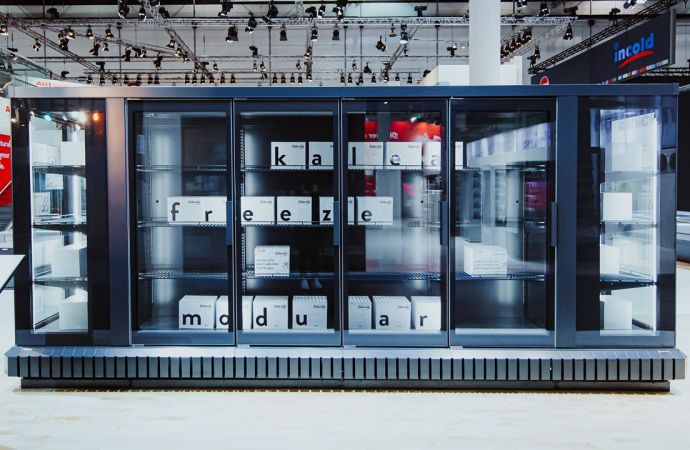ASHRAE Research Project 1807 cites technician training, refrigerant odorization and other requirements in place in other regions.

As the U.S. adopts the use of larger charges of flammable hydrocarbon refrigerants, it can learn from the safety standards and guidelines already in place in other regions, said Bill Goetzler, managing director, Navigant Consulting.
Speaking at the AHR Expo in Chicago in January, Goetzler cited the results of a new report on this topic that Navigant compiled for the American Society of Heating, Refrigerating and Air-Conditioning Engineers (ASHRAE). The report, dubbed ASHRAE Research Project 1807: Guidelines for Flammable Refrigerant Handling, Transport, Storage, Equipment Servicing, Installation and Dismantling, evaluates the risks of using flammable refrigerants throughout the lifecycle of the equipment and the potential opportunities for mitigating those risks.
Covering A3 and A2L refrigerants, the report is expected to be released soon online.
Hydrocarbon refrigerants are currently more widely used in other regions, including Europe, Japan, Australia and Canada. For the ASHRAE 1807 research, Navigant examined the systems and processes used in those regions, and identified gaps where standards and practices in the U.S. could be addressed.
The research covered residential and commercial air conditioning and refrigeration systems, and examined practices in place for all stages of the product lifecycle, excluding the manufacturing stage for the equipment and refrigerants and the final destruction stage for the refrigerants.
It's important when we talk about flammable refrigerant safety to pay particular attention to the risks throughout product lifecycle.”
– Bill Goetzler, Navigant Consulting
Of the lifecycle stages examined in the report, installation/service and removal/dismantling of equipment and refrigerants were deemed the most high-risk because of the potential for a release of the refrigerants in proximity to an ignition source. The storage and transportation stages were deemed a low risk, and the routine operation stage was deemed a moderate risk.
While thorough regulations and procedures around the safe storage and transportation of flammable and hazardous materials in general are already well-established in the U.S., Goetzler said other countries have certain additional restrictions that are not in place in the U.S. and should be considered. Other practices and guidelines from around the world noted in the report include requirements for the odorization of flammable refrigerants, restrictions on the proximity of refrigerants to heat sources during storage and transport, and limits on storage to minimize the risk of theft.
Installation and service are the areas where proper guidelines, training, certification and standards are the most important, Goetzler explained. The lines carrying flammable refrigerants may be opened during various servicing operations, and service personnel also may be working with a high-temperature ignition source.
“Those are really places to be very careful and to be sure we've got standards and guidelines in place to minimize the risk,” Goetzler said. “That's why it's important when we talk about flammable refrigerant safety to pay particular attention to the risks throughout product lifecycle, not just during operation. There are a lot of controls in place, but during service — well, as we know, all kinds of things can go wrong.”
In the U.S., for example, the researchers identified as a gap the lack of training and certification requirements for technicians specific to flammable refrigerants. Certification is required in Europe, Japan and Australia, for example (although not in Canada). In addition, other regions around the world have standard emergency procedures after the detection of a leak, as well as standards for leak testing and for safely charging equipment.
Although the operational stage of systems using flammable refrigerants poses less safety risk than installation and service due to the safeguards built into in the design of the equipment, the report does cite some examples of standards and guidelines in other regions that address operational issues. These include requirements for ventilation rates, the use of leak detection alarms, and restrictions on the proximity to combustion devices of equipment containing flammable refrigerants.
“That would be, of course, very challenging in the United States where we've got furnaces, boilers, water heaters very proximate to air conditioners,” said Goetzler. “But, that sort of requirement does exist in other places.”
Other operational issues the report identified as gaps in the U.S. include guidelines for the use of non-permanent fittings. In fact, another ASHRAE research project is looking specifically at the risks of leakage from a variety of fittings.
In addition, while the U.S. has guidelines and restrictions surrounding venting of refrigerants during the dismantling and decommissioning of equipment, those guidelines are primarily tied to the environmental impact rather than the flammability of the refrigerants. But Canada, for example, specifies how flammable refrigerants should be recovered and has requirements for the disposal of the refrigerants and the temporary shutdown of systems.
Mitigating risks
The report concludes that the risks of using flammable refrigerants can be mitigated through rigorous regulations, codes and standards. And, although code and standard development must be adapted to each individual country, which could take several years, the adoption of international model codes and multinational standards could accelerate the process.
In developing safety standards, Goetzler said, it is important to closely examine existing regulatory regimes and to take local building practices into consideration. In developing technician training, a range of equipment and building types should be considered. In addition, he said, there must be stringent enforcement mechanisms for following these procedures in order to motivate safe practices.
“In summary, I think we know most countries have accepted the importance of flammable refrigerants as alternatives,” said Goetzler. “There's a broad range of readiness to safely deploy flammable refrigerants. We can mitigate those risks with regulations, codes and standards that are adapted to many countries, and all the international standards [currently in place] certainly can facilitate that process.”
Additional research about the use of flammable refrigerants is forthcoming, including ASHRAE Research Project 1806 (Flammable Refrigerants Post-Ignition Risk Assessment) and 1808 (Servicing and Installing Equipment Using Flammable Refrigerants: Assessment of Field-Made Mechanical Joints), which focuses on systems using R32.
Safety and risk management research firm Gexcon US, which released a report on the fire hazards of ASHRAE A3 refrigerants for the Fire Protection Research Foundation last year, is the prime contractor for the ASHRAE 1806 project, slated for completion late this year. This project, which covers both A2L and A3 refrigerants, will consider a risk assessment of the creation of hydrofluoric acid in the combustion of A2L refrigerants, he said.
Creative Thermal Solutions, a research and consulting firm specializing in heating, air conditioning and refrigeration systems, is leading the research for ASHRAE 1808, which is expected to be completed soon.
Related stories



